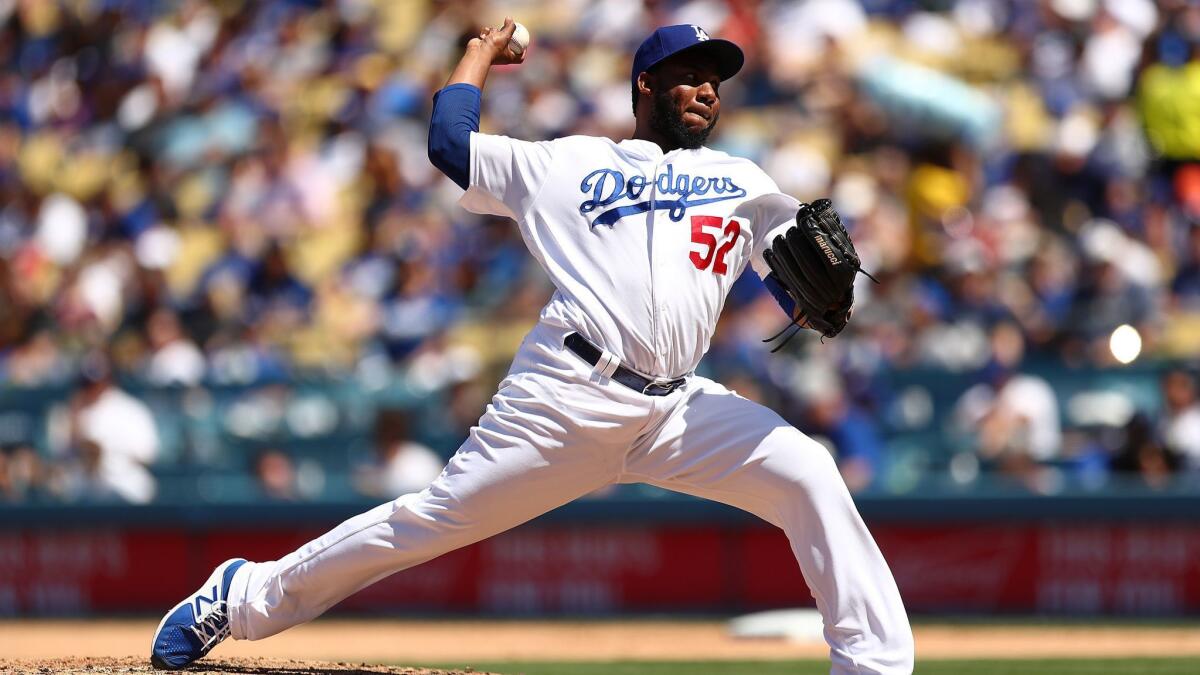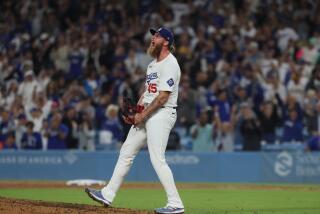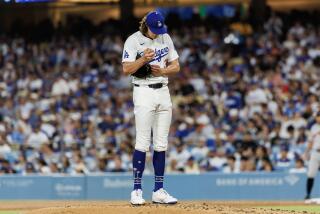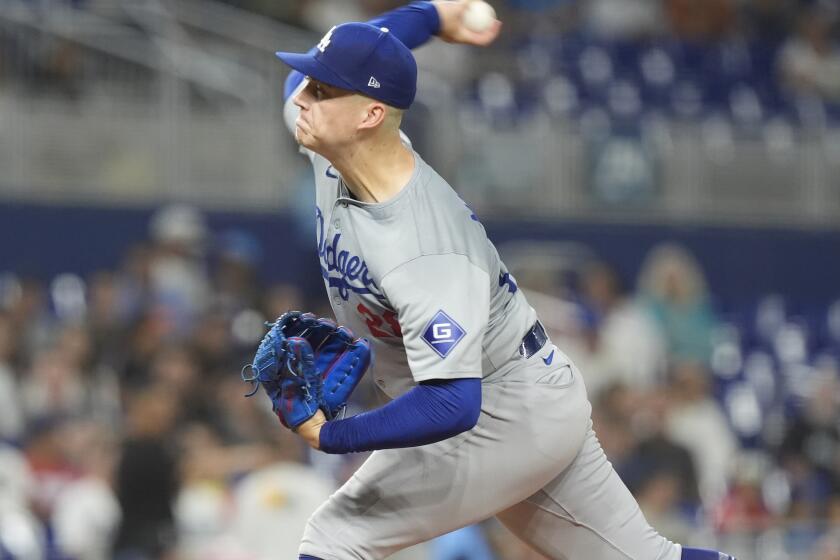Dodgers reliever Pedro Baez shrugs off boos, quietly gets the job done

Reporting from PITTSBURGH — Pedro Baez does not talk much at work. To his teammates. To the coaching staff. To the media. The stout right-handed pitcher is, by all accounts, particularly quiet. His peers, Spanish speakers included, say he’s always been that way. He keeps to himself now that he’s evolved into one of baseball’s best relievers, and he kept to himself when he was a punchline in Southern California and beyond.
Those days weren’t too long ago. Baez was ceaselessly lambasted for his unhurried pace on the mound — his Baseball Reference page lists “The Human Rain Delay” as one of his nicknames — and, above all, his bungles in prominent situations. The boos at Dodger Stadium grew so loud, so intense, so consistent that manager Dave Roberts came to his defense with a direct condemnation of the fans in September 2017. Baez was left off the Dodgers’ playoff roster the next month.
“In spite of the bad moments that have happened, us, as athletes, we always have those moments,” Baez, 31, said in Spanish in a recent, rare interview. “But, thank God, sometimes those moments help us come out better and more focused on finding success and focusing more on going out there and doing things right.”
Baez’s spot was not in question last October. He was in the midst of the best stretch of his career, a two-month run born in mid-August that has continued into this season. Since Aug. 13, Baez has posted a 1.99 earned-run average in 40⅔ innings. His .148 batting average against is tied for seventh among relievers with at least 30 innings during the span. His .209 on-base percentage against ranks fifth and his .211 slugging against ranks fourth.
He isn’t the star of the Dodgers’ bullpen. He isn’t its big-money free-agent acquisition or a former teenage sensation. But Baez has been the reliever Roberts feels most comfortable thrusting into a blaze. In the fifth inning with the bases loaded. In the eighth inning with the meat of the order due up. He’s tested and retested.
And he’s quietly remaking his image.
“Dude,” Dodgers pitcher Ross Stripling said, “he sits down there, he doesn’t say a word and the phone rings and he just takes off his sweater and goes and pitches.”
Closer Kenley Jansen recalls a conversation he had with Baez in the bullpen in Philadelphia two years ago. Baez had blown a one-run lead against the Phillies the previous day in a spectacular way, allowing four runs in a seventh inning he couldn’t escape.
Jansen empathized. They navigated the farm system together on similar paths, former position players converted to high-leverage relievers while dealing with the challenges of adjusting to a different country. Baez came from the Dominican Republic and Jansen from Curacao. But while Baez had been a third baseman, Jansen had been a catcher. A pitcher’s mindset was not foreign to him.
So that day, they talked about pitching, about sequencing and game situations, aspects of the craft that are assumed learned by the time a pitcher reaches Baez’s level. Baez didn’t begin pitching until 2013 — he had 519 plate appearances in high Class-A and double-A in 2012 — and ascended quickly, making his major league debut in 2014.
“Things could’ve gone wrong for him, but he didn’t allow that,” Jansen said. “He had that strong mind that, you got to do it. Just to see him step up, mentally wise, how much he matured and turned his career around, that’s awesome.”
Baez’s continued evolution unfolded with the development of his changeup, a pitch that can be tied to his effectiveness down the stretch last season. Baez threw a changeup 13% of the time in his 36 outings before Aug. 13 last season, according to Brooks Baseball, and was charged with 17 earned runs in 37 innings. That number was 24% from Aug. 13 through the postseason. He allowed one run in 19⅓ innings over his final 19 regular-season appearances before giving up two runs across 11⅓ innings in 10 playoff games.
This season, more than 35% of Baez’s pitches have been changeups. He’s thrown 130 of them and has yet to yield a hit. A fastball averaging 95.9 mph and a slider complete his arsenal.
Sign up for our Dodgers newsletter »
“I had the changeup, but I just didn’t have the confidence that I had at the end of last year and I’ve had at the beginning of this year,” Baez said. “It’s more confidence. I can throw it in any situation. And I’ve been working on my changeup in practice, on flat ground, in the bullpen to continue having success.”
Hitters are slashing just .179/.241/.234 against Baez, whose explosive four-seam fastball sits at 96 mph, a tick slower than it was two years ago. He’s allowed one home run in 21⅓ innings. He’s allowed only 14 hits and four walks while striking out 22 and has allowed four of 16 inherited runners to score. His pace has even picked up. Last season, he was the fifth-slowest pitcher in baseball with an average of 26.5 seconds between pitches, according to Baseball Prospectus. This season, he’s down to an average of 24.8 seconds.
Baez can also consider himself fortunate. The 103-mph line drive Willy Adames of the Tampa Bay Rays cracked off his right knee Tuesday could’ve fractured a bone. Baez thought it did. But X-rays were negative, and he could return to the mound as early as Friday against the Pittsburgh Pirates. The Dodgers will need him to solidify a faulty relief corps. Without him available Wednesday, the bullpen combusted in a seven-run seventh inning in a loss to the Rays.
Those kinds of implosions were, fairly or not, attached to Baez very recently. They stained his career. He’s quietly gone about trying to bury that in the past.
“He’s a workhorse, a super competitor and a guy who really cares,” Roberts said. “I’m very sympathetic toward people who are accountable, and I’m proud of the way he’s handled everything.”
Twitter: @jorgecastillo
More to Read
Are you a true-blue fan?
Get our Dodgers Dugout newsletter for insights, news and much more.
You may occasionally receive promotional content from the Los Angeles Times.











